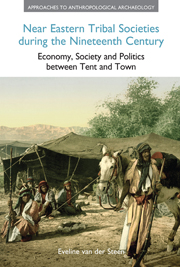 Near Eastern Tribal Societies during the Nineteenth Century
Near Eastern Tribal Societies during the Nineteenth Century There is a tide in the affairs of men.
Which, taken at the flood, leads on to fortune;
Omitted, all the voyage of their life
Is bound in shallows and in miseries.
On such a full sea are we now afloat,
And we must take the current when it serves,
Or lose our ventures.
(Shakespeare, Julius Caesar, Act 4)Introduction
The oldest written sources containing information about territorial interaction and politics involving local groups date from the Middle Bronze Age. The Egyptian execration texts provide us with lists of these groups, their leaders and territories. The story of Sinuhe tells about wandering Bedouin in the desert, and about power skirmishes with the local tribes around Byblos. In Mesopotamia, records describe the battle between the “desert and the sown” – Amorite nomadic groups who invaded territories at the expense of the settled population and created tribal states. The sources tell us little about the social organization of these groups, but what they offer suggests that it was not very different from the organization of the tribes from later periods, known from Assyrian and Babylonian records, the biblical narrative, or Roman and Byzantine sources, such as Ammonius and pseudo-Nilus. Islamic historians, and occasionally early European pilgrims such as Arculf, give information about the organization of early Islamic tribes. There is much that we do not know, and our understanding of past societies is likely to be coloured by a more modern perspective. However, these sources show that there is continuity, not in the history of the region, which is chequered enough, but in the structures and forces that shaped it.
To save this book to your Kindle, first ensure [email protected] is added to your Approved Personal Document E-mail List under your Personal Document Settings on the Manage Your Content and Devices page of your Amazon account. Then enter the ‘name’ part of your Kindle email address below. Find out more about saving to your Kindle.
Note you can select to save to either the @free.kindle.com or @kindle.com variations. ‘@free.kindle.com’ emails are free but can only be saved to your device when it is connected to wi-fi. ‘@kindle.com’ emails can be delivered even when you are not connected to wi-fi, but note that service fees apply.
Find out more about the Kindle Personal Document Service.
To save content items to your account, please confirm that you agree to abide by our usage policies. If this is the first time you use this feature, you will be asked to authorise Cambridge Core to connect with your account. Find out more about saving content to Dropbox.
To save content items to your account, please confirm that you agree to abide by our usage policies. If this is the first time you use this feature, you will be asked to authorise Cambridge Core to connect with your account. Find out more about saving content to Google Drive.